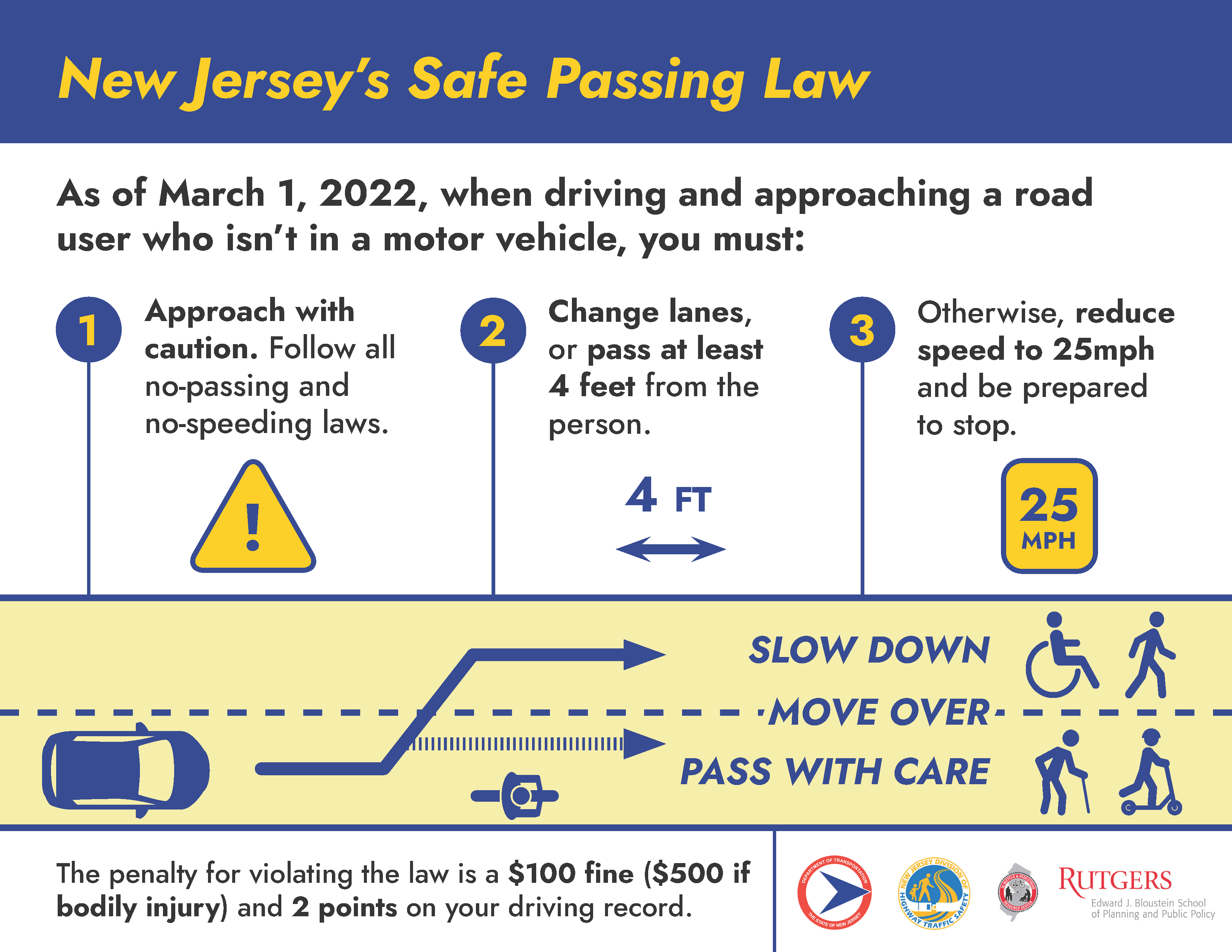New Jersey’s Safe Passing Law
New Jersey’s Safe Passing Law went into effect on March 1, 2022 (NJSA 39:4-92.4). The law provides clear rules of the road for all motorists when interacting with vulnerable road users (people on foot, bicycle, scooter, in a wheelchair, or otherwise not in a car, bus, or truck). Check out (or download and print out) our Fact Sheet explaining the new law!
This new law aims to prevent the near misses, injuries and deaths that can occur when motorists pass cyclists, pedestrians, or other vulnerable road users. The law contributes to a cultural shift toward safer travel habits by reinforcing the right to the road for people on foot, wheelchair, bicycle, or scooter. The law also underscores the responsibility for those driving fast, heavy vehicles to be cautious around vulnerable road users, who could be their friends, family, or neighbors.
How does the law work?
Drivers are required to use “due caution” whenever they encounter vulnerable people on the road, meaning:
- Drivers must move over a lane (if there’s one to move into) while following all current no-passing and no speeding laws.
- On a single-lane road, drivers must provide a distance of at least 4 feet to safely pass a vulnerable road user.
- If 4 feet is not possible, drivers must slow to 25 mph and be prepared to stop until they can pass safely without endangering those sharing the road.
Violating the law results in a $100 fine (causing bodily injury results in a $500 fine and 2 motor vehicle points).
English
Español
Yes. Fatalities are on the rise. Every day, people experience risky passes that leave no margin for error, sometimes with fatal consequences.
The first step is direct education given to drivers who violate the law – the primary purpose of Safe Passing Laws are education, awareness, and a cultural shift around sharing space on the road, rather than a means to punish negligent motorists. However, the Safe Passing Law also joins the existing Move Over Law and the Stop and Stay Stopped Law in providing police with a specific citation for unsafe driving.
- Cyclists may legally take the full lane for their own safety. They can also legally ride two-abreast as far to the right as “practicable,” providing they do not “impede traffic.”
- Slow down, approach with due caution, and yield until it’s safe to pass every person in the group with four feet of space.
- Only move back into the lane when safely beyond the front of the group. Do not cut off the group to make a turn in front of them.
If a 4-foot safety zone is not available, drivers must slow to 25 mph and be prepared to stop until they can pass safely without endangering those sharing the road.
Slow down to 25 mph, approach with due caution, and move over a lane if possible. Leave four feet of space from the person sharing the road—not the painted line on the road.
Slow down, approach with due caution, and yield to the person sharing the circle until it is safe to pass.
While separated infrastructure (like sidewalks) are safer than legal protection alone, not all roads have sidewalks, and some sidewalks may be in poor condition and unsafe to jog on.
Drivers should approach vulnerable users of all kinds with due caution and pass safely, regardless of whether they ‘should’ be in the road or not.
The New Jersey Safe Passing Law Resource Center at NJ Bike & Walk Coalition
The New Jersey Bike & Walk Coalition hosts a Safe Passing Law Resource Center which provides details about the law, social media materials, and other educational resources. Included on this website are a google form to collect contact information from those who are interested in receiving updated about the availability of outreach materials and a Safe Passing Pledge. By signing the pledge, one agrees to support safe passing by slowing down, moving over, and passing vulnerable users safely with room to spare. The Safe Passing Law Resource Center is supported with federal funds through the NJ Division of Highway Traffic Safety.
Support for education about the NJ Safe Passing Law is provided by the New Jersey Department of Transportation and the New Jersey Division of Highway Traffic Safety with funds provided by Federal Highway Administration.

